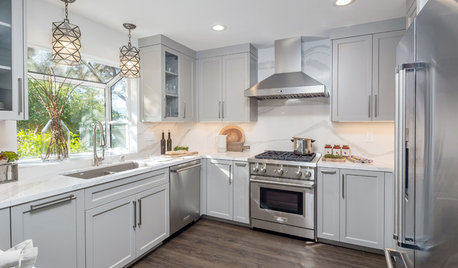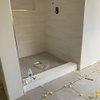NuCore performance SPC flooring
Iain Birnie
3 years ago
Featured Answer
Comments (9)
salonva
3 years agolast modified: 3 years agoIain Birnie
3 years agoRelated Discussions
Vinyl Flooring: Paradigm Waterproof Flooring
Comments (159)We ended up switching from an LVP to Mohawk RevWood Plus, which is a laminate that has a “WetProtect” lifetime surface and subfloor waterproof warranty, maximum scratch protection, and a lifetime “All Pet” warranty against pet stains. We are SO happy we decided to switch from LVP to this laminate, for a couple of reasons. We are still getting the water protection benefit of the LVP, while also getting the durability of a higher quality laminate, and for less money. Another huge plus, in our opinion, is that the “grain” in the surface of the laminate is visual without being abrasive. The Paradigm flooring was actually rough enough that I could not run a dust mop across the boards easily, only in the directions the boards were laid—which isn’t always the most convenient way of doing things. The laminate is enough smoother than this is not an issue, and is also MUCH more comfortable on bare feet, and gentler on socks and the knees of our little grandies crawling across it. Just my $0.02....See MoreOptiMax Eco Resilient Flooring
Comments (182)We had the beaumont flooring installed throughout our whole house (minus the bathrooms). When we purchased from F&D I noticed this specific color had been discontinued and was on sale (still expensive though!). I asked why and was told that the color was no longer on trend. I didn’t believe that but took his word for it and felt lucky the color I wanted was on sale! We bought 1800 sq ft worth, and hired their contracted installer. Prior to installing, I spoke with the main installer about the flooring and mixed reviews I had read. He assured me this is a top quality flooring and if done right with the proper underlayment, it will be perfect and last for a long time and that he had installed this flooring for years. So we went with his suggestions and had them install. 6 months later and we are experiencing the same buckling and separating issues mentioned in these reviews. We reached out to the installers about our issues and they came over to inspect. They said the floor shouldn’t be doing what it’s doing and that they would have to speak with their manager before any repairs can be done. But now we are unable to get anyone to take our call or call us back from the install/contractor’s office. They are avoiding us, argh!! I am hesitant to even bother contacting F&D, especially since their contractor is blowing us off. Has anyone looked into a lawsuit? I think we’d have a good case. Here are a few pics, but they don’t do it justice. It’s much worse looking in person....See MoreNuCore Performance Luxury Vinyl Flooring Review
Comments (113)I just purchased the LVP NuCore form the F&D. The installers started to put the floor down but it was breaking. This is a common theme with tis product. I believe it is because it is so rigid/brittle. I tried to take it back to the F&D but they stated behind the product and said that installers made a mistake when putting floor in. I lost about $1500 with F&D as even though it was bad product they didn't take the opened box back. It was so frustrating since the workers lost time installing the floor and then taking it down. I was very disappointed with customer service. I will try to contact NuCore directly about this product. Just FYI few boxes were ok, but a lot of them were breaking. they also packed couple of boxes broken in half....See MoreSuperCore WeShipFloors experiences?
Comments (31)@toycar77 Shaw Floorte Elite Prodigy HDR MXL Plus Golden Age was the one we were waiting on for over 6 months and then when that got pulled from market while we were waiting (bullet dodged apparently) we were waiting on one of their tile styles and the Shaw rep from our flooring retailer said those were being pulled too because of installation issues (I think the joints were cracking during install). They both are part of their new “mineral core” planks/tiles so might have something to do with the mineral core? They are “updating” them now but all we could find out was that it might be the end of the year (with no real known date at this time). I don’t know if the smaller planks are affected though (the Prodigy ones that aren’t MXL plus) because there was just the one color and size that we were interested in that tested well in our fabric test (at least the three samples we had at the time). They clearly released the product before it was actually ready so I’m not sure if I’d trust the “update” until it’s tested in the real world! Plus, at this point, it’s hard to have any faith that the new updated version will have a non-destructive finish. I would say fingers crossed on that one but I’d rather hope for finding something better sooner!...See Moresalonva
3 years agosalonva
3 years agoHU-854329743
3 years agoJ B
2 years agoSady Ali
2 years agoMelanie Reimer
last yearlast modified: last year
Related Stories

MATERIALSWhat to Know About Luxury Vinyl Flooring
The flooring material has become increasingly popular. Here’s how to determine its quality and get it installed
Full Story





Iain Birnie